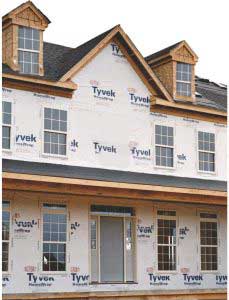When homes are constructed, they include what is commonly called a “house wrap.”  This is a thin layer of protection installed between the structure and its outside covering. In order to provide maximum benefit, the house wrap must be installed properly.
This is a thin layer of protection installed between the structure and its outside covering. In order to provide maximum benefit, the house wrap must be installed properly.
What is a House Wrap?
A house wrap is a layer of specially-designed materials installed over the wooden frame of the home and beneath any outside covering like siding, brick or stucco to prevent air, dust and moisture from circulating from the exterior areas to the home’s interior. It can also serve as a thermal, or radiant, insulation barrier to help save money on heating and cooling costs, and inhibit mold growth. If used or installed incorrectly, it can negatively affect your home’s ventilation and air flow and cause a mold buildup.
Older homes typically don’t have house wrap, as it was not required at the time. However, newer homes most often include this protective layer. A house wrap must comply with all federal, state and local building codes for smoke and fire safety.
Almost any type of home should use a house wrap, with wood-sided homes being the most susceptible to water infiltration. Other types of siding, like aluminum or vinyl siding can also benefit, as they too offer cracks between planks where water an infiltrate. Siding methods that completely cover a home, like brick, stucco or other masonry products require a specific type of house wrap that can help alleviate moisture that can collect between the siding and the home’s cavities.
What you don’t want to do is completely cut off the natural ventilation that is required for a healthy home. By oversealing sealing cracks and gaps, air flow can be compromised.
DuPont’s Tyvak House Wrap Requirements
DuPont™ makes a series of products in its Tyvek® house wrap line for water-resistive and air barriers and in order for this barrier to be effective, there are certain installation practices and guidelines that need to be followed.
According to DuPont, their Tyvak HomeWrap™, Tyvek StuccoWrap™, Tyvak DrainWrap™ and Tyvek ThermaWrap™ LE must be covered within four months (120 days) of installation. The company’s Tyvek CommercialWrap™ and Tyvek CommercialWrap™ D must be covered within nine months (270 days) of installation.
There are other special considerations as well:
- For buildings with fewer than five stories, DuPont recommends installation of a high-pressure skirt to help prevent water intrusion at the sill or threshold.
- Certain products must be installed with drainage grooves facing a vertical orientation, going up and down.
- For optimal R-value benefits, the ThermaWrap™ must be installed with the shiny, metallic side facing towards a clear ¾-inch minimum airspace, although the ThermaWrap™ will still act as a water-resistive barrier without an airspace.
- For stucco exteriors, the ThermaWrap™ should face an interior wall, even over shear wall, when the majority of the façade is stucco in open stud construction.
Related: DuPont™ Tyvek® Water-Resistive and Air Barriers Installation Guidelines for Open Stud Construction
Proper House Wrap Installation is Important
To meet building codes, and to protect both the home and its inhabitants, a house wrap must be properly installed by a qualified contractor. Using the wrong type of house wrap, or having it improperly installed can create moisture and mold problems.
Suspect a Problem with your House Wrap? Contact Först Consulting Group
Först Consulting Group is an expert at forensic investigations for construction practices. We can help you prior to your home’s construction to assist with selecting a great contractor or the right house wrap products. And we can help you understand why house wrap must be installed properly. We can also investigate claims against a contractor or manufacturer and help you build a case to remediate a problem. We’re on your side. Contact us today—before it’s too late.
Check out our other Homeowner Services for project management, estate management and construction contract review.




